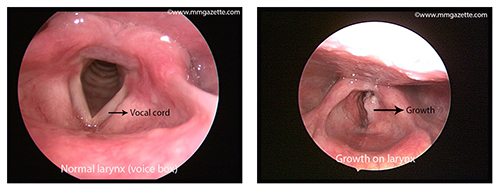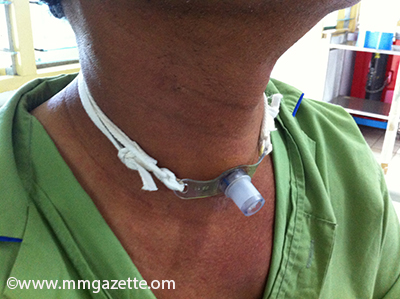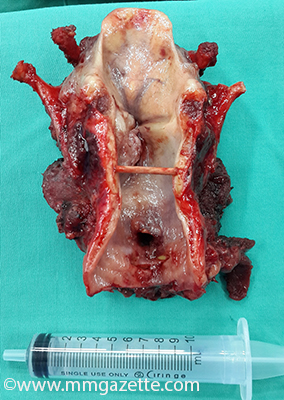
Source: www.theguardian.com
I am sure everyone has seen the recent campaign to reduce smoking. Gory pictures are printed on cigarette packs to put some sense of regret while they open the plastic and the top. How much has this really worked? I would humbly share one of the peculiar stories which closely resemble the image on one of the boxes.
Mr Daniel (not his real name) is our common guy: works hard in his office for a living, loves his wife & 4 children, and prays to God. Out of his 55 years of living, he spent 35 years of it smoking. He was smoking one pack per day, but lately half the amount. He consumes alcohol occasionally, but not to a point of getting drunk.
He started having occasional cough for months. Subsequently, he had a change in his voice and it never came back to normal. He thought it was fine, and continued working as usual. However, for the past one month, he had reduced effort tolerance- climbing stairs at work was previously a simple task for him, but he was gasping for breath even after 1 flight of steps.
After much persuasion, he went to his usual doctor, who then referred him to an ENT Specialist. Here, an endoscopic laryngoscopy (a fiber optic tube inserted through your mouth or nose to examine your voice box, vocal cords and epiglottis) was done. His worst nightmare came true! He had been diagnosed with cancer of his voice box.
Cancer of the larynx (voice box) affects mainly the male, as in most country, men smoke more than women. However, in Western community, the number of laryngeal cancer in females is on the rise as more females smoke at this day and age. Smoking tops the risk factor for getting this cancer, similarly for lung cancer, as both are related with the inhalation of carcinogenic chemicals. Combination of smoking & alcohol increases the risk of cancer by 15 times.
Signs and symptoms of cancer of larynx include:
- Hoarseness of voice
- Blood stained sputum
- Neck swelling
- Weight loss
- Noisy breathing (stridor)
- Difficulty in swallowing (dysphagia)
- Reduced effort tolerance
- Difficulty in breathing

Image 1 & Image 2
An endoscopic laryngoscopy can be done in the ENT Clinic to view the voice box, without much pain, and can be done under 1 minute. Image 1 shows a normal larynx while image 2 shows a growth on the left vocal cord.
Mr Daniel was then subjected for direct laryngoscopy under general anaesthesia. Biopsy (sample) of the growth was taken for histopathological examination (examination of sample under the microscope). The growth on the larynx was too large, it was obstructing the airway, and a small airway surgery was done to bypass the growth. This procedure is called tracheostomy, where it is a temporary measure done to secure airway till definitive plan for cancer is

Post tracheostomy
available. CT scan was done to see extent of the lesion; thankfully it has not spread to other parts of his body.
Biopsy is mandatory to look for the type of cancer, which will later determine his treatment. CT scan will also determine whether the cancer is suitable for surgery. CT scan is most useful to look for spread of cancer, particularly in the lung and liver, where this cancer usually spreads. In case of metastasis (distant cancer spread), surgery is no longer an option.
Mr Daniel was then offered for definitive treatment. He agreed for total laryngectomy. This involved removal of the voice box and part of upper food passage, also known as pharynx. He understood that he will lose his natural voice and have slight difficulty in swallowing post operatively.
For small laryngeal cancer, radiotherapy or local excision using laser is adequate. In his case, total removal of his voice box was necessary as the cancer was rather advanced. Most patients refuse losing their natural

Laryngectomy specimen
voice, and therefore refuse surgery. Majority of those refusing surgery ultimately return with residual cancer despite chemotherapy & radiotherapy. There are methods of voice restoration using natural techniques and electronic device.
The surgery went smoothly as planned. His pain was well controlled with adequate painkillers at the initial part. His food intake was via nasogastric feeding tube for the first 1 to 2 weeks till his food passage wound have fully sealed. He is currently awaiting radiotherapy six weeks post-surgery.
Feeding via tube is essential as the wound need to heal and seal adequately so that food and liquid would not leak into the neck spaces, which later could cause infection. Patients will be able to take solids later, but not able to take big bolus of food as the upper food passage is roughly half the size it was before. Radiotherapy is essential for clearance of microscopic tumours which may manifest later in months to come.
Many others like Mr Daniel have walked the same path. Some have succumbed despite adequate treatment, being the aggressive nature of this disease. Some are still under our follow up. Healthy, alive and very well remembered, they are the unique type of patients, as most will speak to us in a distinctive robotic speech.
I realise this is such futile attempt to make anyone cease smoking, but hopefully it is just enough to acknowledge the truth behind the picture. Just maybe, we will be courageous enough to let our loved one know that we care enough for them and subsequently they will quit that awful habit.
Dr. Ahmad Nordin is an ENT surgeon currently working in Sabah. Find out more about him on The Team page.
[This article belongs to The Malaysian Medical Gazette. Any republication (online or offline) without written permission from The Malaysian Medical Gazette is prohibited.]
Reference:
- PL Dhingra. Diseases of the Ear, Nose and Throat 4th Edition
- http://www.cancer.net/cancer-types/laryngeal-and-hypopharyngeal-cancer accessed on 7 Dec 2013.
